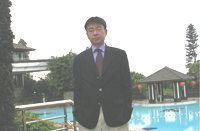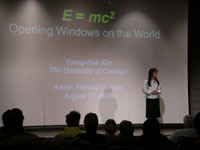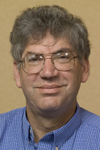 |
|
|
 |
Carrière Internationale

Jie Gao, IHEP, China |
Physicist Jie Gao started his international scientific research career at
LAL/IN2P3/CNRS, France 16 years ago. Since 1992 he has been concentrating
on accelerator physics for the linear collider, which was the subject of
his "Habilitation à diriger des recherches" obtained in 1996. Before coming
back to IHEP, China as a professor in January 2005, he worked on and collaborated
with SBLC/TESLA at DESY, CTF2/CLIC at CERN, NLC at SLAC,
and ATF at KEK. He appreciates not only working with top accelerator physicists
on different linear collider projects around the world, but also contributing to the
ILC as a great school of education both in science and humanism.
As a member of ILC GDE, he now convenes the damping ring working group (WG3b).
His research interests vary from the global design of
linear colliders, beam dynamics, damping rings, to the beam
dynamics of storage ring colliders. Working with J. Seeman
of SLAC on the beam-beam dynamics of PEP-II, he now plays a role in
the upgrade program of the Beijing Electron Positron Collider, named BEPC-II,
at IHEP in Beijing.
He attended the Snowmass Workshop for the first time
and enjoyed the atmosphere and dynamism of the meeting.
"Detailed discussions with people such as Barry Barish and Shin-Ichi Kurokawa
are very fruitful in forecasting China's participation in ILC
collaborations," Gao says. "ILC is the main trend of the
community of high energy physics and accelerator physics and
technology world wide. As a personal point of view, China, as
an ultra-fast developing
country in economics and science in particular, with its special advantages,
should and could play its role just as in other large
international scientific collaboration programs, such as ITER.
As an Asian country, regional collaboration with other Asian
coutries is of the same importance compared with other regions."
Gao also serves as a panel member of ICFA beam dynamics committee, and as a
guest professor at Beijing University and SINAP, host institute of
Shanghai Light Source. He is also a referee of Physical Review and Physical Review
Letters.
--Youhei Morita
|
 |
|
|
 |
Upcoming meetings, conferences, workshops
ILC Industrial Meeting
Fermilab, USA, 21-22 September, 2005
SMTF Collaboration Meeting
Fermilab, USA, 5-7 October 2005
Nanobeams 2005
Kyoto, Japan, 17-21 October 2005
ECFA ILC Workshop
Vienna, Austria, 14-17 November 2005
TESLA Collaboration Meeting and GDE Meeting
Frascati, Italy, 5-10 December 2005
2006 LCWS 2006
Bangalore, India, 9-15 March 2006
|
E=mc2: Opening Windows on the World

Fermilab's Young-Kee Kim presenting a public lecture in Aspen on August 17.
Download the talk.
|
|
 |
 |
|
|
 |
Linear Collider Forum of America Sponsors ILC Industrial
Meeting at Fermilab
The Linear Collider Forum of America will sponsor an International Linear
Collider Industrial Forum on September 21-22 at Fermilab. More than 100
scientists, engineers and industry leaders from the United States, Asia

A TESLA type super-
conducting cavity,
assembled by ACCEL
in Germany. |
and Europe are expected to attend.
Following a number of successful discussions at the SRF2005 and
Snowmass ILC Workshop, the main goal of this upcoming meeting is
to provide industry with technical information about the International Linear Collider. In turn, scientists hope to receive some insight from industry leaders as to how to develop a model for the ILC industrialization. "The purpose from the lab's point of view is to transfer information," said Fermilab Associate Director Steve Holmes. "At Snowmass we had great discussions between the labs, universities, and industry on models of collaboration in both the R&D and construction phases. There was also great communication between industries in the three regions. We are looking to build on these discussions at the September meeting."
On the first day of the forum, Fermilab and SLAC scientists, among others,
will provide background information about the ILC. Fermilab Director Pier
Oddone, GDE Director Barry Barish and GDE-Americas Regional Director Gerry
Dugan will all provide updates on the status of the ILC and industrialization.
Industry leaders from Europe and the Japan Linear Collider Forum will also
give status reports on the industry activities in each region. The second
day of the forum will focus on more specific technical areas such as cryomodules
and vacuum systems. "We all have to work together to get a
clear picture of costing and engineering on this truly global project,"
said Michael Peiniger of ACCEL, an R&D-oriented company in Germany that
supplies superconducting cavities, complete srf modules and
other accelerator components and systems worldwide. "Participating in the
industrial forum at Fermilab
is important for both the scientists and the industries. The important thing
is to gain more momentum and to talk to each other."
Interested scientists and industries are welcome to attend the forum free of
charge. All industries should register with Ken Olsen,
President of the Linear Collider Forum of America. For more information about
the forum, contact Maxine Hronek in the GDE
ILC office. A complete agenda will be available online at the
LCFOA Web site
and the ILC Web site soon.
--Elizabeth Clements
|
 |
|
|
 |
|
 |
 |
|
|
 |
|
The two-week linear collider workshop at Snowmass is now over. Both the 2nd ILC Workshop and the 2005 International Linear Collider Physics and Detector Workshops were great successes. Holding these two workshops together proved to be a very good idea because they provided many opportunities for the accelerator and the physics/detector communities to interact (plenary sessions, noon time accelerator physics tutorials, coffee breaks, etc).
Snowmass was a big milestone for the GDE. It was the first time the 49 members of the Global Design Effort met together to begin our work. The first week at Snowmass was primarily organized along the lines of the accelerator working groups that were formed last fall at the 1st ILC Workshop. The main GDE influence was adding six global working groups that met each afternoon to begin focusing on overall design issues such as costing, facilities, operations, machine parameters, machine detector interface, etc). These groups made very good progress on these issues.
After the first week of the workshop, the GDE members and working group leaders
met on Saturday, 20 August, to plan the second week. In addition to continuing
the work begun in the first week, our goals for the second week were to concentrate
on identifying the decisions that will need to be made to develop a complete

Tom Himel |
baseline configuration and to make conclusions or recommendations on them, where
possible.
Tom Himel greatly facilitated this process by assembling a list of more than
40 items, which were used to focus the discussions
for the second week. Conclusions and
recommendations from each working and global group, as well as for the
"Himel List," are being assembled and they will soon be available on our
ILC Website. This will provide the starting point for the GDE work this
fall toward a Baseline Configuration Document (BCD) by the end of the year.
Read more
--Barry Barish
Director's Corner Archive
|
 |
|
|
 |
Physicist Announces New Grants
From Inside Oregon,
27 August 2005
Preparations for history's most ambitious science project are on schedule according to the University of Oregon physicist who co-chairs national and international teams preparing to use "Einstein's telescope" when it roars to life in 2015.
Jim Brau announced $817,000 in new funding for the project from the U.S. Department of Energy and the National Science Foundation during his closing address at the two-week workshop on the International Linear Collider . About 650 scientists from around the globe gathered at Snowmass, Colorado, to develop the technical designs and scientific plans for this massive project.
Read more
|
|

